|
|
| | | 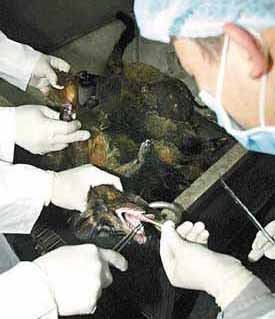 | | | Medical workers obtain a saliva sample from a dead civet cat at the Guangzhou Sanitarian Treatment Factory in South China's Guangdong Province January 7, 2004. Guangdong authorities have ordered the slaughter of about 10,000 civet cats to avert another SARS outbreak. The confiscated civet cats will be drowned in tanks filled with disinfectant and then steamed for six hours in autoclaves where temperatures can reach up to 200 degrees Celsius. [newsphoto] | | | | | | | | | | | | | 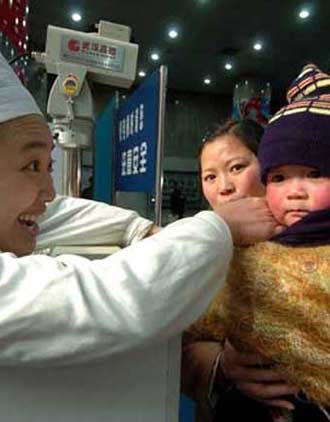 | | | A health worker checks the temperature of a toddler as a precaution at a railway station in Beijing Jan 7, 2004. As China officially launched its busiest travel period of the year yesterday, security and medical monitoring moves are geared up to prevent the spread of SARS. Transport officials expect 1.89 billion people to visit relatives or go sightseeing during the Lunar New Year holiday. | | | | | | | | | | | | | 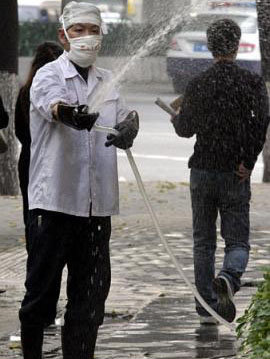 | | | A Chinese hospital worker wearing a mask washes the sidewalk outside the No. 8 People's Hospital, where a SARS patient has been treated in Guangzhou, South China's Guangdong Province, Jan 6, 2004. The first confirmed SARS patient in the Chinese mainland since last July has 'fully recovered' and will be discharged from the hospital on Thursday. [AP] | | | | | | | | | | | | | 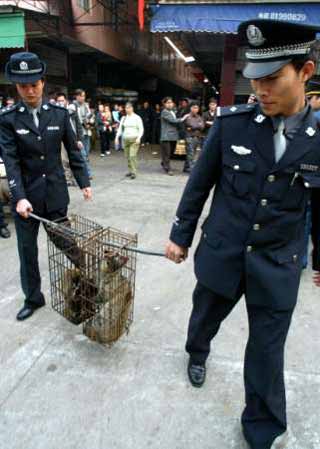 | | | Two police officers carry confiscated civet cats during a raid at a wild animal market in Guangzhou, South China's Guangdong Province January 5, 2004. Guangdong, which is monitoring is first confirmed SARS patient in months, will kill about 10,000 civets and close wild animal markets to eliminate the possible source of the disease. [Reuters] | | | | | | | | | | | | | 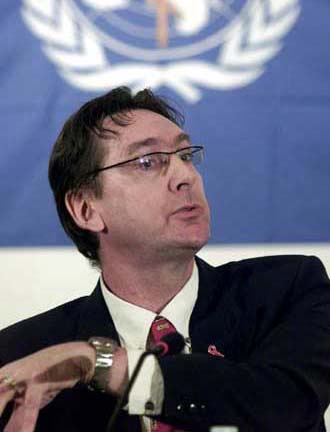 | | | Henk Bekedam, World Health Organization representative in China, expresses his confidence about traveling within the country at a news conference in Beijing, Jan 5, 2004. The WHO on Monday said it is important to stress that although the suspected SARS case has now been confirmed, this does not indicate there is an immediate public-health threat in Southern China. [newsphoto.com.cn] | | | | | | | | | | | | | 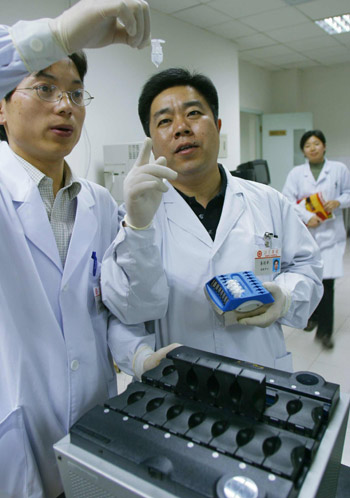 | | | Dr. Cai Jianping (right), head of a SARS (severe acute respiratory syndrome) research lab with Beijing Hospital, carries out an experiment with an assistant November 2, 2003. Cai's lab has succeeded in cloning the genes of SARS coronary virus, putting an end to the lack of SARS viruses in research. [Newsphoto] | | | | | | | | | | | | | 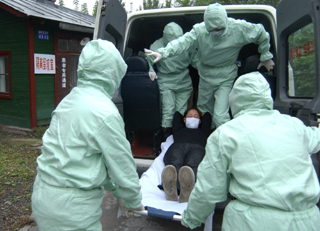 | | | Medical staff carry a "SARS (severe acute respiratory syndrome) patient" to a hospital in an anti-SARS drill held in Harbin, Northeast China's Heilongjiang Province September 27, 2003. China is on alert against a possible resurgence of the epidemic after a new SARS case was reported in Singapore. [newsphoto.com.cn] | | | | | | | | | | | | | 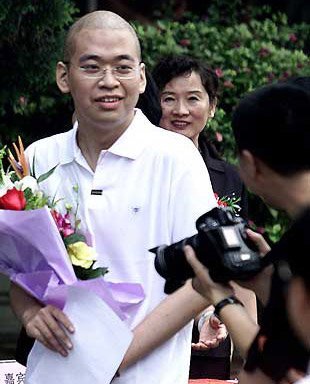 | | | Sun Zheng, one of the Chinese mainland's last two SARS patients, walks out of Beijing Ditan Hospital August 16, 2003. The remaining two patients, Sun Zheng, a 19-year-old university student, and Lu Zhiyan, a 45-year-old medical worker, were declared free of SARS more than 20 days ago. They stayed in hospital to undergo treatments on complications caused by SARS. [newsphoto.com.cn] | | | | | | | | | | | | | 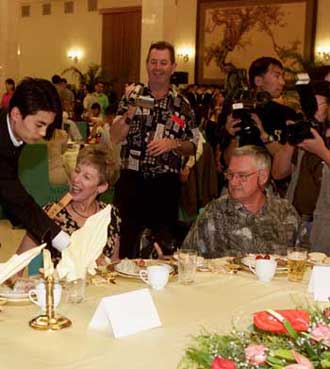 | | | POST-SARS FREE FEAST: A tour group from Australia enjoy a free feast at the Great Hall of the People in Beijing on the evening of July 4, 2003. The banquet welcomed 500 overseas tourists as part of the Beijing Tourism Bureau's measures to revive the city's tourism sector. The bureau will hold a feast every Friday for first 1,500 overseas tourists to visit Beijing after the World Health Organization removed the city from its list of SARS affected areas.[newsphoto.com.cn] | | | | | | | | | | | | |  | | | Wang Xiaoli answers questions from reporters as she is discharged from a Guangzhou hospital in South China's Guangdong Wednesday, July 2, 2003. Wang is one of the last three severe acute respiratory syndrome (SARS) patients who were discharged from hospitals Wednesday in Guangdong. The province, one of the hardest-hit regions in the world, had a total of 1,512 SARS cases and 58 deaths. [newsphoto.com.cn] | | | | | | | | | | | | | 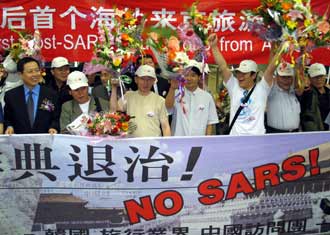 | | | A Korean tourist group comprising 60 sightseers arrives at the Beijing Capital International Airport on June 30, 2003, the first such group the city has received since the outbreak of SARS two months ago. Last week, the World Health Organization has removed Beijing and other Chinese mainland areas from SARS-affected areas. [newsphoto.com.cn] | | | | | | | | | | | | | 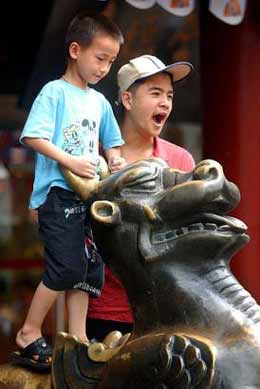 | | | Tourists play at a statue of Chinese unicorn on Monday, July 7, 2003, at Yu Garden, one of the most popular tourist destinations in Shanghai. China has started a promotion to restore the tourism industry, severely affected since last April by SARS outbreak in the country. For China, revenues from overseas tourists had declined about 50 percent. | | | | | | | | | | | | |  | | | During his visit to Amoy Gardens in Hong Kong Monday, Premier Wen Jiabao holds a three-month-old baby boy whose mother died of SARS. The virus, which killed nearly 300 people in Hong Kong, hit Amoy Gardens the hardest of all the residential apartment blocks in the region. [newsphoto.com.cn]
| | | | | | | | | | | | | 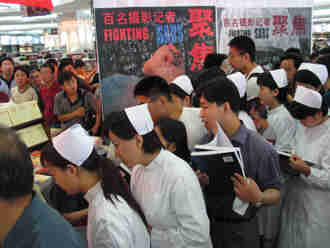 | | | Beijing's nurses and residents queue up for copies of a new pictorial collection entitled "Fighting SARS", Sunday, June 29, 2003, which was made available Sunday. The photo album includes a collection of 200 special photos by some 100 Chinese and foreign press-photographers to chronicle China's efforts against SARS.[newsphoto.com.cn] | | | | | | | | | | | | | 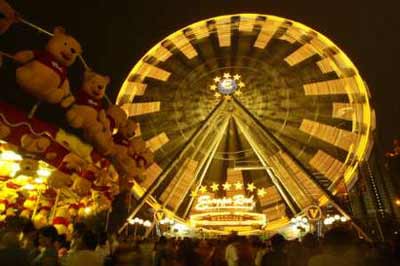 | | | Visitors flock near a ferris wheel ride called 'Europa Rad,' at the World Carnival tour in Shanghai late July 6, 2003. The carnival, which was delayed due to the SARS outbreak, has already attracted thousands of visitors and will run for a month. China has launched a campaign to revive tourism industry, virtually dead since late April when the Severe Acute Respiratory Syndrome erupted. For the whole country, revenues from overseas tourists had declined 49 percent year on year in April. [Reuters] | | | | | | | | | | | | |  | | | Jubilant tourists prepare to board buses outside the Beijing Exhibition Hall, for a local sightseeing tour organized yesterday following the World Health Organization's lifting of its SARS-prompted travel advisory against Beijing.[newsphoto.com.cn]
| | | | | | | | | | | | | 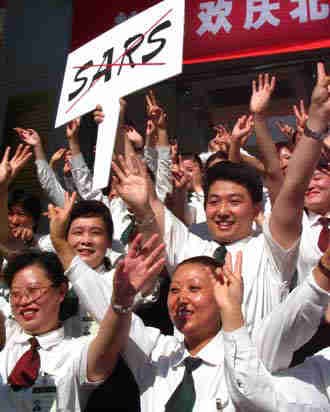 | | | Staff at the Dongan Market on Wangfujing Street celebrate Beijing's victory over SARS June 24. The World Health Organization Tuesday removed Beijing from its list of SARS-infected areas and lifted a travel advisory against the city.[newsphoto.com.cn] | | | | | | | | | | | | | 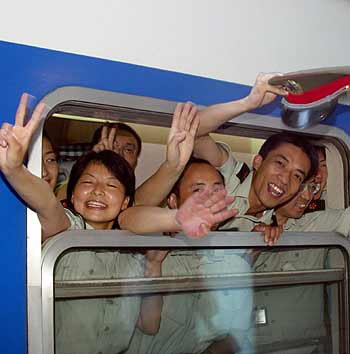 | | | Liu Rui (left), a 25-year-old nurse, gives a victory salute as her train pulls out of Beijing West Railway Station en route for Lanzhou Monday evening. Liu was among 98 medics from the No 451 Hospital in Lanzhou, northwestern Gansu Province, recruited to work in Beijing's Xiaotangshan Anti-SARS Hospital. All of the 1,300 doctors and nurses transferred from around the country left Beijing for their working units in the army on Monday after fulfilling their missions to combat SARS outbreak. [Xinhua] | | | | | | | | | | | | |  | | | Shigeru Omi, WHO regional director for the western Pacific region, announces Tuesday that World Health Organization has lifted travel advisory on Beijing June 24, 2003. Omi said the decision was based on consideration of factors including the number of current SARS cases, quality of surveillance measures and the effectiveness of prevention measures.[Xinhua] | | | | | | | | | | | | |  | | | Hong Yun (Center), one of the last recovered SARS patients in Beijing's Xiaotangshan Hospital, poses for the camera after being released from the facility June 20, 2003. Standing beside Hong are several family members, who came to greet her and medical staff at the hospital, which discharged its last 18 patients on Friday. [newsphoto.com.cn] | | | | | | | | | | | | |  | | | Passengers pour off a train at Beijing Railway Station June 17, 2003. Effective containment of severe acute respiratory syndrome has encouraged people, mostly migrant workers, to travel back to the capital again. [newsphoto.com.cn] | | | | | | | | | | | | |  | | | A make-up promotion draws in customers at Victoria Department Store in North China's Inner Mongolia Autonomous Region June 17, 2003. Business in the region is gradually recovering, after 20 days with no new SARS cases reported. [newsphoto.com.cn] | | | | | | | | | | | | |  | | | Vice Minister of Health Gao Qiang explains the numbers of SARS cases in Chinese mainland during the World Health Organization (WHO) Global Conference on SARS at a hotel in Kuala Lumpur, Tuesday, June 17, 2003. With signs continuing to point toward SARS being brought under control globally, the WHO opened an international conference Tuesday by saying it is considering lifting its travel warnings on Beijing and Taiwan. [AP Photo] | | | | | | | | | | | | |  | | | Vice-Minister of Health Gao Qiang (R) meets Director General of Taiwan Province's Center of Disease Control, Dr. Ih-Jeb after the opening of the WHO's first global conference on SARS in Kuala Lumpur on June 17, 2003. About 1,300 scientists, medical experts and public health officials are expected to participate in the two-day conference. [Reuters] | | | | | | | | | | | | |  | | | Job-seekers, mostly rural migrant workers from provinces neighbouring South China's Guangdong Province, arrive at Guangzhou June 12, 2003. The Guangdong labour authorities have now lifted a recruitment ban against local enterprises hiring such workers. The ban was earlier established to control the spread of SARS. [newsphoto.com.cn] | | | | | | | | | | | | |  | | | David Heymann, World Health Organization executive director for communicable diseases, said at the joint press briefing hosted by the Chinese Ministry of Health and WHO in Beijing Thursday that SARS-related information offered by China was "informative and complete ". [newsphoto.com.cn]
| | | | | | | | | | | | |  | | | Members of the women's drum group of the cultural centre in northeast Beijing's Chaoyang District rehearse in high spirits June 11, 2003, despite the drizzle after having stopped for more than one month due to the SARS outbreak. Cultural and entertainment activities have been resuming now that the worst is over for the virus-hit city. [newsphoto.com.cn] | | | | | | | | | | | | | 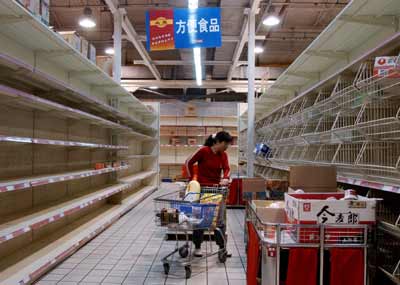 | | | A woman shops in an almost empty supermarket on April 24, 2003 as Beijingers went on a shopping spree after the SARS outbreak. [newsphoto.com.cn] | | | | | | | | | | | | | 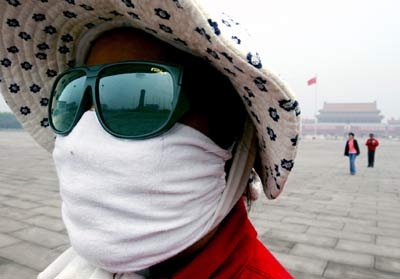 | | | A masked woman walks on the Tian'anmen Square in Beijing on May 1, 2003. The outbreak of severe acute respiratory syndrome forced most Beijingers to wear masks when going out. [newsphoto.com.cn] | | | | | | | | | | | | | 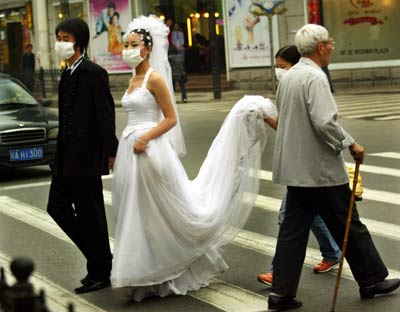 | | | A masked newly-wedded couple walks on a street in Wuhan, central China's Hubei Province on May 6, 2003. [newsphoto.com.cn] | | | | | | | | | | | | | 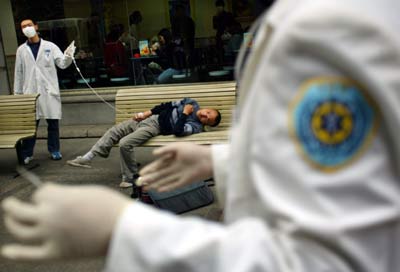 | | | Medical workers carry out emergency treatment on a suspected SARS patient on April 29, 2003 in Wuhan, Central China's Hubei Province. [newsphoto.com.cn]
| | | | | | | | | |
|
|
|
|
 |


